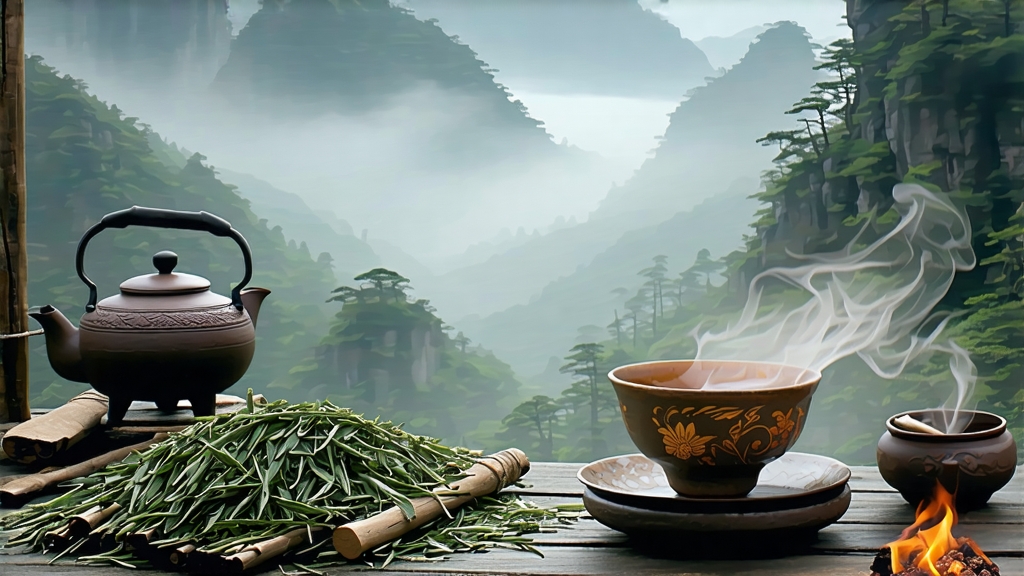
Ask most tea lovers to name a Chinese black tea and they will answer Keemun or perhaps Yunnan Gold; few realize that the very first black tea ever created still grows on the same rugged slopes where it was born four centuries ago. Lapsang Souchong—literally “small sort from Lapu mountain”—is not merely a curiosity for the smoke-obsessed palate; it is the genetic and cultural ancestor of every black tea on earth. Understanding its journey from Ming-dynasty serendipity to Victorian drawing-room staple, and learning how to coax its layered sweetness from a gaiwan, is to hold a living fragment of global tea history in your cup.
Origin and legend
The Wuyi massif in northern Fujian is a UNESCO dual heritage site where 36 peaks and 99 valleys create a humid micro-climate veiled in cloud for two-thirds of the year. Local tea gardens sit between 600 and 1,200 m on weathered volcanic soil that drains quickly yet retains minerals; the result is a leaf that is thick, wax-cut, and intensely aromatic. According to village chronicles kept in Tongmu Guan, the first black batch was an accident of 1646, when Qing troops forced farmers to abandon freshly picked leaves. Upon return the next morning, the green had oxidized overnight. To salvage the crop, the farmers rushed the darkened leaf over pine fires used for drying vegetables; the smoke not only masked the musty edge but imparted a haunting resinous note. Traders from the Dutch East India Company tasted the tea at Xingcun port, paid triple the price of green, and by 1669 Lapsang was listed on London customs scrolls as “bohea,” a corruption of “Wuyi.” Thus the world’s first fully oxidized tea entered global commerce, and every subsequent black tea—Assam, Ceylon, Kenyan—owes its existence to this Fujian prototype.
Terroir-defined sub-styles
Today only leaf picked within the 565 km² core Wuyi reserve may legally bear the name Zheng Shan Xiao Zhong (“Original Mountain Small Sort”). Outside the reserve, counties such as Zhenghe, Jianyang and even coastal Fuding produce Waishan Xiao Zhong, pleasant but thinner. Within Tongmu itself, three micro-climates yield distinct profiles. Guadun, the highest hamlet, gives a cool-fermented leaf with cocoa and longan sweetness; Miaowan, facing east, receives morning sun and delivers a brighter, citrus-accented cup; while the west-facing Dafang produces the most resinous, almost medicinal liquor prized by Russians who still sweeten it with black cherry jam. A fourth, very rare “unsmoked” style called Zheng Shan Xiao Zhong Yuan Wei has recently emerged for the domestic market: the same cultivar and withering protocol but finished in electric ovens, allowing international drinkers to taste the tea’s innate honeyed malt without the campfire cloak.
From leaf to liquor: the craft
Harvest begins around Qingming when the standard is one bud plus two leaves, plucked at 60 % opening to balance polyphenols and amino acids. The leaves are spread 3 cm deep on bamboo trays inside Qing-era wooden sheds whose window slats are cracked just enough to let mountain breeze enter. Over 8–10 hours the leaf loses 65 % moisture, softens, and begins to emit a faint apple-like aroma; this is the critical withering phase that black teas elsewhere achieve with hot-air tunnels, but in Tongmu only ambient mountain air is trusted.
Once limp, the leaf is rolled for 45 minutes on 55 cm diameter rattan baskets lined with cotton cloth. Pressure is applied by barefoot artisans who shuffle in a rhythmic side-to-side motion, breaking cell walls evenly without overheating the leaf. Oxidation follows in wooden troughs recessed into the earth floor; the tea is piled 10 cm deep and turned every 30 minutes while temperature is monitored by hand—when the palm placed on the pile feels like touching a child’s forehead, it is time to turn. After 3–4 hours the leaf has turned a uniform mahogany and smells of ripe plums.
Now comes the signature pine-smoke stage. Local Masson pine, rich in resin, is cut into 60 cm logs and burned in a sunken pit at the centre of the firing room.